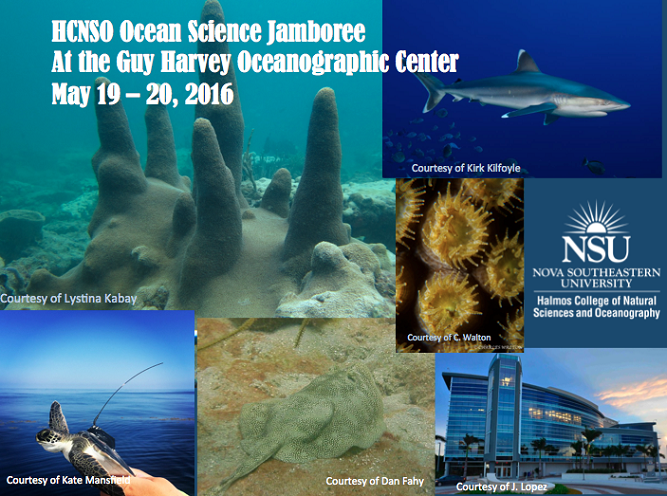DNA Analysis of Surfactant Associated Bacteria in the Sea Surface Microlayer in Application to Satellite Oceanography
Location
Guy Harvey Oceanographic Center Facility
Start
5-20-2016 4:45 PM
End
5-20-2016 5:00 PM
Abstract
The sea surface microlayer (SML) covers more than 70% of the Earth, links the hydrosphere with the atmosphere and is critical in Earth’s processes, especially air-sea gas exchange and the cycling of organic material (Carlson et al. 1988; Cunliffe et al. 2013, Liss and Duce 2005). The SML and the near subsurface water are known to contain surface-active materials (surfactants), which alter surface tension forces. The main focus of this work is surfactant-associated bacteria, which serves as an indicator for presence of slicks on the sea surface. Sources of surfactants also include deposition from the atmosphere, terrestrial runoff, phytoplankton and, perhaps, marine animals. The slicks can be seen by synthetic aperture radar (SAR) satellite images.
We are studying the bacterial content of the sea surface microlayer and surfactant-associated bacteria using DNA analysis. We have implemented a new approach, which has significantly reduced potential contamination of microlayer samples during collection, handling and processing at the lab (Kurata et al. 2015; Hamilton et al. 2015). Microlayer sampling has been done in the Straits of Florida and the Gulf of Mexico during TerraSAR-X and Radarsat-2 overpasses.
More recently, as a part of the Gulf of Mexico Research Initiative (CARTHE), over 100 samples (SML and subsurface combined) have been collected during a research cruise between February 6 and February 12, 2016 in the Gulf of Mexico near De Soto Canyon. Some of them were reasonably close to the time of a TerraSAR-X satellite overpass. We will discuss these experiments and future plans for expanding the observational sites to several locations in the World Ocean. The marginal ice zones in the Arctic and Antarctic are of particular interest due to rich microbial environment during some seasons.
DNA Analysis of Surfactant Associated Bacteria in the Sea Surface Microlayer in Application to Satellite Oceanography
Guy Harvey Oceanographic Center Facility
The sea surface microlayer (SML) covers more than 70% of the Earth, links the hydrosphere with the atmosphere and is critical in Earth’s processes, especially air-sea gas exchange and the cycling of organic material (Carlson et al. 1988; Cunliffe et al. 2013, Liss and Duce 2005). The SML and the near subsurface water are known to contain surface-active materials (surfactants), which alter surface tension forces. The main focus of this work is surfactant-associated bacteria, which serves as an indicator for presence of slicks on the sea surface. Sources of surfactants also include deposition from the atmosphere, terrestrial runoff, phytoplankton and, perhaps, marine animals. The slicks can be seen by synthetic aperture radar (SAR) satellite images.
We are studying the bacterial content of the sea surface microlayer and surfactant-associated bacteria using DNA analysis. We have implemented a new approach, which has significantly reduced potential contamination of microlayer samples during collection, handling and processing at the lab (Kurata et al. 2015; Hamilton et al. 2015). Microlayer sampling has been done in the Straits of Florida and the Gulf of Mexico during TerraSAR-X and Radarsat-2 overpasses.
More recently, as a part of the Gulf of Mexico Research Initiative (CARTHE), over 100 samples (SML and subsurface combined) have been collected during a research cruise between February 6 and February 12, 2016 in the Gulf of Mexico near De Soto Canyon. Some of them were reasonably close to the time of a TerraSAR-X satellite overpass. We will discuss these experiments and future plans for expanding the observational sites to several locations in the World Ocean. The marginal ice zones in the Arctic and Antarctic are of particular interest due to rich microbial environment during some seasons.


